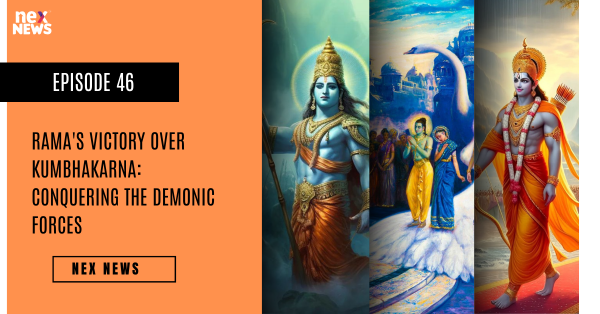The Ramayana, an epic that transcends time and space, unfolds the saga of Lord Rama's divine journey, laden with challenges and triumphs. Among the many formidable adversaries faced by Rama, Kumbhakarna, the colossal and powerful demon, stands as a symbol of the darker forces that threaten to disrupt cosmic harmony. Rama's victory over Kumbhakarna not only serves as a pivotal moment in the narrative but also carries profound lessons about the eternal struggle between righteousness and demonic forces.
Kumbhakarna: The Mighty Demon
Kumbhakarna, the brother of the demon king Ravana, is a figure of immense strength and ferocity. Endowed with a colossal body and insatiable appetite, Kumbhakarna poses a formidable challenge to Rama and his divine quest. His loyalty to Ravana, despite the latter's unrighteous actions, underscores the depth of the demonic forces that oppose Rama's virtuous path.
Rama's Quest for Dharma
At the heart of the Ramayana is Rama's unwavering commitment to dharma – righteousness and moral duty. Exiled from his kingdom and separated from his beloved wife Sita, Rama embarks on a journey to uphold dharma and restore cosmic order. Kumbhakarna, aligned with the demonic forces led by Ravana, becomes a formidable obstacle in Rama's quest for justice and righteousness.
Kumbhakarna's Penance and the Boon of Sleep
The origin of Kumbhakarna's extraordinary power lies in a penance he performed to seek the favor of Lord Brahma. Impressed by Kumbhakarna's devotion, Brahma offered him a boon. However, due to a misunderstanding, Kumbhakarna sought the boon of everlasting sleep instead of invincibility in battle. This misstep proves to be a crucial factor in the later events of the Ramayana, as Kumbhakarna's immense strength is overshadowed by his prolonged periods of slumber.
Kumbhakarna's Awakening: The Turning Point
As Ravana faces increasing setbacks in the battle against Rama and his army of Vanaras (monkey warriors), he turns to his mighty brother Kumbhakarna for assistance. Awakened from his prolonged sleep, Kumbhakarna is roused to join the battle. His colossal form and thunderous roar create an aura of fear on the battlefield, and it seems as if the tide might turn in favor of the demonic forces.
The Battle of Lanka: Rama's Strategic Brilliance
The confrontation between Rama and Kumbhakarna becomes a pivotal moment in the Ramayana. Rama, armed with his divine bow and arrows, faces the formidable challenge posed by Kumbhakarna's colossal presence. Recognizing the immense strength of his adversary, Rama employs strategic brilliance, directing his army to weaken Kumbhakarna before engaging in direct combat.
Strategic Maneuvers: Hanuman's Role
Hanuman, the devoted ally of Rama, plays a crucial role in the battle against Kumbhakarna. Utilizing his unparalleled strength and agility, Hanuman engages in a series of strategic maneuvers to distract and disarm Kumbhakarna. His ability to navigate the battlefield with swiftness and intelligence proves instrumental in creating opportunities for Rama to strike at the heart of the demonic forces.
Rama's Divine Arrows: Precision and Power
Rama, armed with his divine weaponry, launches a relentless assault on Kumbhakarna. Each arrow, guided by divine precision, seeks to exploit the vulnerabilities of the mighty demon. Rama's skill as an archer, coupled with the blessings of divine weaponry, showcases the triumph of righteousness and virtuous combat over sheer brute force.
The Duel of Titans: Rama vs. Kumbhakarna
As the battle intensifies, Rama and Kumbhakarna engage in a formidable duel. The clash between the divine and demonic forces reverberates through the battlefield, capturing the essence of the eternal struggle between good and evil. Rama's unwavering commitment to righteousness and dharma becomes evident as he faces the colossal adversary with courage and determination.
Kumbhakarna's Defeat: Symbol of Righteous Triumph
Despite Kumbhakarna's immense strength, his protracted periods of sleep become his downfall. Rama, recognizing this vulnerability, seizes the opportune moment to strike a decisive blow. The defeat of Kumbhakarna becomes a symbol of the triumph of righteousness over demonic forces, illustrating that even the mightiest adversaries can be vanquished through strategic wisdom and unwavering commitment to dharma.
The Cosmic Harmony Restored
Rama's victory over Kumbhakarna marks a significant milestone in the larger narrative of the Ramayana. The defeat of this mighty demon contributes to the restoration of cosmic harmony and paves the way for the ultimate showdown against Ravana, the epitome of demonic arrogance and unrighteousness. The virtuous triumph of Rama sets the stage for the fulfillment of his divine purpose – the rescue of Sita and the establishment of dharma.
Lessons from Rama's Victory Over Kumbhakarna
The tale of Rama's victory over Kumbhakarna imparts timeless lessons that resonate beyond the realms of mythology:
Strategic Wisdom: Rama's approach to the battle underscores the importance of strategic thinking in the face of formidable challenges. The precision and intelligence with which he confronts Kumbhakarna serve as a guide for individuals navigating their own battles against adversities.
Commitment to Dharma: Rama's unwavering commitment to righteousness and dharma remains the guiding force in the face of demonic opposition. The victory over Kumbhakarna reinforces the idea that adherence to moral and ethical principles leads to triumph over the forces of darkness.
Recognition of Vulnerabilities: Rama's recognition of Kumbhakarna's vulnerability – his prolonged periods of sleep – emphasizes the importance of discernment in facing challenges. Understanding the weaknesses of adversaries and exploiting them strategically becomes a key aspect of righteous combat.
Triumph of Virtue: The defeat of Kumbhakarna symbolizes the ultimate triumph of virtue over vice. It serves as a reminder that, no matter how powerful the forces of darkness may seem, they are ultimately subdued by the brilliance of righteousness.
Conclusion
Rama's victory over Kumbhakarna in the Ramayana stands as a testament to the eternal struggle between the forces of good and evil. The narrative unfolds not merely as a mythological tale but as a symbolic representation of the cosmic balance that pervades the universe. The defeat of Kumbhakarna becomes a crucial chapter in Rama's divine journey, contributing to the larger narrative of restoring dharma and righteousness. The lessons derived from this triumph – strategic wisdom, commitment to dharma, recognition of vulnerabilities, and the ultimate triumph of virtue – continue to resonate as timeless guidance for individuals navigating the complexities of their own journeys. The victory over Kumbhakarna becomes a beacon of hope, illustrating that, even in the face of seemingly insurmountable challenges, the light of righteousness prevails.

